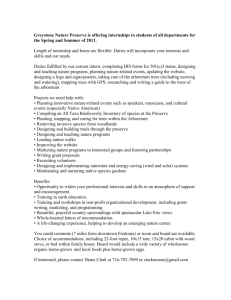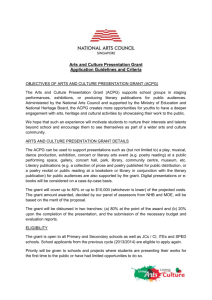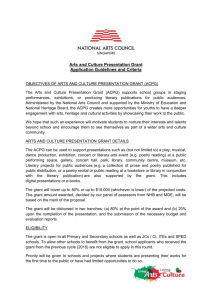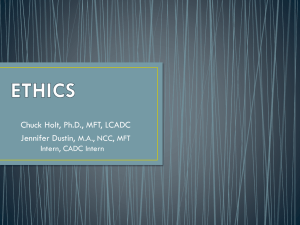STEP News STEP News No 15 Spring 2012 No 15 Spring 2012
advertisement
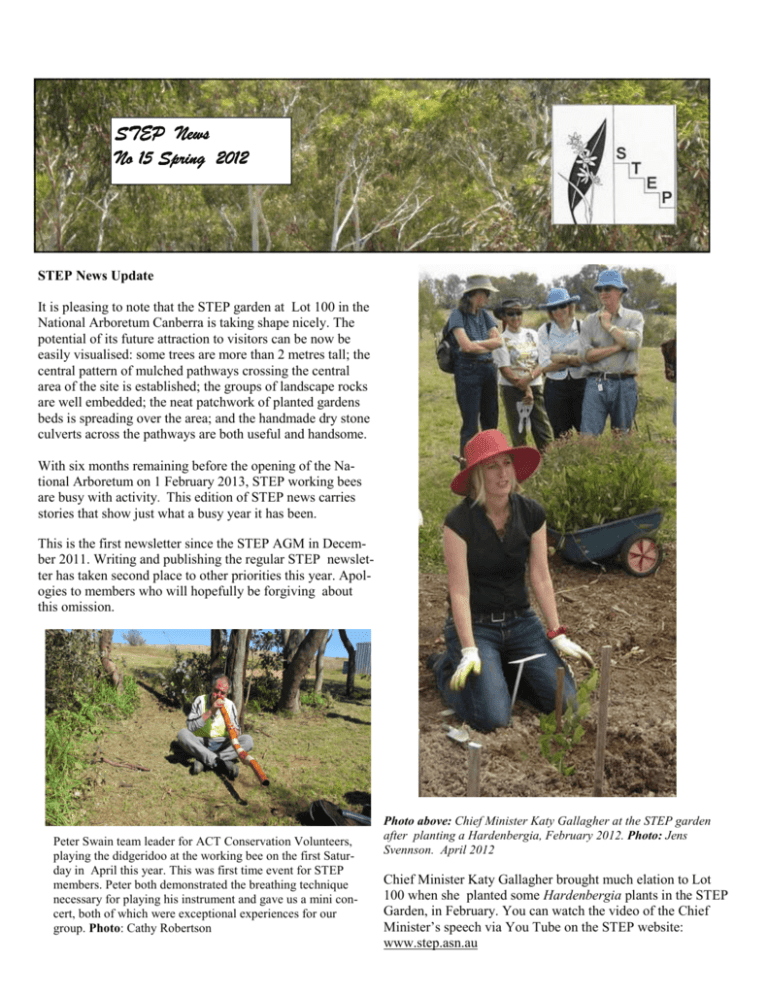
STEP News No 15 Spring 2012 STEP News Update It is pleasing to note that the STEP garden at Lot 100 in the National Arboretum Canberra is taking shape nicely. The potential of its future attraction to visitors can be now be easily visualised: some trees are more than 2 metres tall; the central pattern of mulched pathways crossing the central area of the site is established; the groups of landscape rocks are well embedded; the neat patchwork of planted gardens beds is spreading over the area; and the handmade dry stone culverts across the pathways are both useful and handsome. With six months remaining before the opening of the National Arboretum on 1 February 2013, STEP working bees are busy with activity. This edition of STEP news carries stories that show just what a busy year it has been. This is the first newsletter since the STEP AGM in December 2011. Writing and publishing the regular STEP newsletter has taken second place to other priorities this year. Apologies to members who will hopefully be forgiving about this omission. Peter Swain team leader for ACT Conservation Volunteers, playing the didgeridoo at the working bee on the first Saturday in April this year. This was first time event for STEP members. Peter both demonstrated the breathing technique necessary for playing his instrument and gave us a mini concert, both of which were exceptional experiences for our group. Photo: Cathy Robertson Photo above: Chief Minister Katy Gallagher at the STEP garden after planting a Hardenbergia, February 2012. Photo: Jens Svennson. April 2012 Chief Minister Katy Gallagher brought much elation to Lot 100 when she planted some Hardenbergia plants in the STEP Garden, in February. You can watch the video of the Chief Minister’s speech via You Tube on the STEP website: www.step.asn.au STEP News Spring 2012 Page 2 Update on STEP Thursday Working Bees STEP Tree Workshop An enthusiastic team of Thursday Working Bee members have achieved amazing results at the STEP site. Many thanks go to our regular working bee members including: Jenny Campbell, Bill Handke; Tony Lawson; Mardi Naulty; Jenny Andrews; Max and Margaret Bourke, Andy Fuller; Gael Howell; Barbara Payne; Carmel Maher; Richard Jones; Jens and Maeve Svennson; and Andrew Russell. David Shorthouse organised a workshop held on 17 June to consider tree management principles, policies and practices to guide our tree management program for the foreseeable future. The first session of the workshop provided examples of practical experience from some STEP members and NAC personnel. Adam Burgess (NAC curator) and Mark Richardson (horticultural consultant) outlined NAC practices to date; Max Bourke described lessons learned from managing his arboretum at Tilba and his wide experience gained from assisting with and studying many other arboreta; Jens Svensson presented some statistical inforSTEP volunteers are spending between 30 and 40 hours mation drawn from his records of the trees growing of volunteering work time each week to provide the per- in the STEP garden and his experience as a forestry son power to develop the Lot 100. The site now boasts professional; and well constructed and mulched pathways, hand made dry Barbara Payne, landscape architect who presented stone culverts and well weeded garden beds. STEP is very fortunate to have David and Lainie Shorthouse taking the lead for the construction of the STEP garden. Recognition and a great deal of appreciation are also due to Barbara Payne who has continued to support this project by donating many hours both on and off site to planning and arranging the planting pattern. STEP’s tree management program is under the good care of Jens and Majvi Jenssen, ensuring that the trees on the site have been checked, pruned and staked, numbered and recorded. Thanks to the tree management workshop in May (reported in the next column of this news letter) there is also a plan for tree replacements to cater for the losses that have occurred on the site – mostly due to either damage from the water flow from the car park construc- a computer generated series of graphic modelling tion or to a lesser extent, kangaroos. of the potential canopy growth on Lot 100 at different points of time in the future. Due to the increase in numbers at the working bees, the small table where we have our morning tea has become David later provided a summary of the results of the workshop to the attendees that included the folunable to cope with our group of helpers. This is not a lowing: complaint but cause for celebration! Morning teas always feature a range of gourmet home-made goodies to Lot 100 will certainly change over time and as trees mature. There will be some death/damage to arboshare. The conversation is lively due to the personal retum trees may be related to insects, phytopthora, anecdotes and discussions of mutual interest. Actually STEP is looking for more second hand garden furniture soil saturation. Lot 100 trees can be viewed as a crop or ‘zoo’, removal of trees needs to be accepted – especially fold up chairs. So if you have a second hand steel table or some deck chairs could be can con- or foreshadowed; Larger canopies may need thinning but unlikely for 10 years or so, need to keep in tribute one, please let us know. mind the understorey requirement for shading. Read the remainder of this story on page 5. STEP News Spring 2012 Page 3 Threatened species planting It is exciting that Greening Australia volunteers will be planting Grevillea iaspicula (Wee Jasper Grevillea), a threatened species found in the wild at Wee Jasper at the STEP site. The planting is scheduled during a regular working bee on Thursday 11 October. The plants have been purchased from the Yarralumla Nursery. This species was only named in 1996, though it was first collected in 1986. It is a member of the family Proteaceae. It is only found naturally at six sites around the Lake Burrinjuck and Wee Jasper areas. In total there are only about 100 mature plants left in the wild, making it one of Australia’s rarest plants. It is listed as endangered under the Environmental Protection and Biodiversity Conservation Act 1999 (Commonwealth). The species is endangered due to the heavy grazing of sheep and goats. Most of the remaining plants are in found in rocky areas that have been inaccessible to grazing. At some of the Grevillea iaspicula sites, G. rosmarinifolia is also found. Hybridisation between the two related species does occur, affecting the genetic purity of the rarer of the two species. The NSW National Parks and Wildlife Service and other stakeholders are involved in a recovery program. They are replanting clones of the current populations in several sites to increase its spread and also are using clones to replant at bushfire affected sites. Fencing and weed control work has also been undertaken, blackberries being a significant threat. G. iaspicula is also important in for birds, the flowers providing invaluable nectar. The shrub has an average height of 1.2-1.5 metres, however plants can grow up to 4m high. The leaves are attractive, glabrous and sometimes pungent; the upper surface is noticeably wrinkled. The inflorescence is usually terminal, pendulous, about 2-3 cm long, each with up to ten flowers. The flowers are cream to green, with a pink to red style. It flowers in May to November and the flowers last for several weeks. It fruits in November to December and the seed are released in December to January. The Wee Jasper Grevillea is a stunning addition to a garden with the right soils and is likely to attract native nectar feeding birds.* Image: Courtesy of the ANBG website * Reference: The information about Grevillea iaspicula (Wee Jasper Grev) is taken from the ANBG: http://www.anbg.gov.au/gnp/interns- STEP receives ACT Government Environment Grant 2012—2013. STEP has received an ACT Environment Grant of $9,900 for our project entitled: STEP Master Plan Stage 2 – Out Door Education Space. STEP received this news and a letter congratulating us on our success on 24 August 2012. This project will lead to the development of a simple education and training program to guide practical work undertaken by students and volunteers and include training in techniques for weeding areas to enhance local indigenous plant communities, including box-gum woodland. The full story about the grant is on page 7. STEP News Spring 2012 Page 4 Local plants join the Digital Age Members will be interested to know that David Shorthouse completed the first stage of the STEP interpretative signage project in June. Sixteen signs have been installed along the main pathways highlighting the 16 trees species planted on the site. The signs form the onsite building blocks for the STEP interpretative experience, complementing the Eucalypts of Lot 100 brochure produced by David Shorthouse and Max Bourke. They also complement Barbara Payne’s 5 display panels which are scheduled to be included in a permanent display format in keeping with the NAC signage. In the meantime, members can view the panels on the STEP website. website. All our STEP signage is a design execution of the standard National Arboretum signs. Photo: by Jens Svenssen June 2012. Above: Lot 100 sign for Eucalyptus melliodora: Each sign is hammered into the ground at the base of a tree and displays the symbols for leaf arrangement on the stem, the leaf shape, the fruit and the flowers of a particular species. The signs also include the STEP logo and the barcode. They are robust, attractive and easy to read. National Arboretum (NAC) Signage The NAC standard requirement on each sign is the inclusion of a digitalised bar code. This requirement was the cue for STEP to review our website. The review has been underway since March this year. STEP has engaged both Marianna Rollgejser and Karen Mobbs (KJM) in the website redevelopment project which among many other improvements, includes building the capacity to support the interface between mobile devices and the QR codes on our signs. Each bar code has the ability to connect to the (under construction) STEP website using the Quick Response (QR) code application. The QR code system will enable visitors and students to our site to connect to a suite of pages on the STEP website which will provide images and text about the species and the local ecosystems. Interpretative signage is an important element of the STEP education program. In the longer term, it is expected that our site will have signage for the wetland, the forest, woodland and grassland elements. Proposal for STEP e-newsletter. The STEP Committee hopes to have the redeveloped STEP website ready by the end of this year. The website will include a form for members to subscribe to our newsletter on line. This will save time, cost and carbon emissions as well as free up the newsletter editor from some of the physical activities involved in addressing and posting newsletters to our members. We had been reluctant to move to the online format in the past. However, in keeping with the new digitised signage, it seems logical to make this shift to the digital future and include all the STEP elements at the same time. Above : A photo of some of the plants on display inside the STEP tent at the Festival of the Forests 2012. The plants were donated to STEP by Warren Saunders, Seeds and Plants Australia. Thank you Warren for the generous donations you have made to STEP. STEP News Spring 2012 Page 5 Tree Workshop Report ...continued from page 2 The trees should be managed as ‘good’ or ‘healthy’ examples, a ‘managed’ forest; some lifting of lower branches is warranted; note different species have different growth rates; Some special issues include: ‘double’ trees (e.g. E. nortonii), particular species characteristics, variations in tree form and their educational value; replacement of trees - potential for adding new species, these may increase diversity of Southern Tablelands species and also new ones predicted to come with climate change Photos of Lot 100; Cathy Robertson Left bottom: At the Festival of the Forests 2012, David Shorthouse and Barbara Payne with Linda Muldoon and Lainie Shorthouse in the background. Right bottom: Andy Russell with the Chief Minister, Katy Gallagher, Jens Svennson and others. STEP News Spring 2012 Page 6 STEP seeks to secure its long term vision STEP representatives Cathy Robertson and David Shorthouse were invited to make a presentation to members of the National Arboretum Strategic Board at its meeting held on 27 March 2012. During the lunch break prior to the commencement of the meeting, there was also an opportunity for STEP to display the STEP Master Plan Stage 1 panels and invite the Board members to participate in an informal viewing and discussion of our strategic plans for STEP. Facilities: STEP was invited to share the facilities that will be available in the Arboretum visitors’ centre and the opportunity to participate in discussions and arrangements at the appropriate time. Outdoor education space The Board noted that STEP has been invited to outline a proposal for a low budget outdoor classroom on Lot 100 for the Chief Minister, Katy Gallagher to consider. NAC Education Working group STEP provided an outline of the background discusJohn Mackay, who is the chair of the Board, was most wel- sions with Peter Kanowski for an education program coming and supportive in assisting us with our presentation at the NAC. The Board agreed to establish an educaand in guiding discussion of the issues we raised to reach tion group to be chaired by Anne Duncan and invited decision points in a most expedient manner. His intervenSTEP to join the group. Cathy Robertson has been tion resulted in an agreement by Board members to include nominated as STEP’s representative on this Group. a mention of STEP as an affiliated organisation in the Board’s Charter, noting that STEP is a special partner of Draining damage to Lot 100 the National Arboretum. The Board noted that STEP is currently in discussion with the Arboretum Project Team to agree and impleWith John’s guiding hand to lead the discussion, the Board ment a solution to manage the destruction of the members also offered to investigate the key issues affecting plantings on the Lot 100 caused by the perched water both the National Arboretum and STEP. As part of her table under the newly constructed car park above Lot presentation, Cathy Robertson tabled Chief Minister, Jon 100. Stanhope’s 2009 letter to STEP, highlighting its key points and encouraging the Board to discuss them. Jon Stanhope, In a subsequent letter to the Board, STEP expressed now a Board member himself, was present at the meeting. our appreciation for the support we have received His involvement in this discussion was serendipitous and from the NAC Board and the Project team who have quietly influential. Cathy asked the Board to note that Stan- provided resources and encouragement for develophope’s letter included the promise that the woodland adja- ment of our site. cent to Block 100 would be incorporated into the STEP forest and further that STEP was to be given an additional Photo: John Mackay, NAC Board of Governors Chair. block in the Arboretum. Photo courtesy of the NAC website. During a robust discussion of alternatives, some members of the Board noted that the vacant block which is currently a secondary grassland and part of Glenloch Farm adjacent to the STEP site, may in the future be considered as an additional area for car parking. Cathy pointed out that STEP’s view is that the additional block referred to in the letter is the block between the woodland and Block 100. This issue was postponed to be resolved in further discussions in camera. STEP also requested a response from the Board informing us of any developments arising from this investigation. STEP also noted that the Board would be responding to the letter from Sarah Ryan, the Chair of the National Resource Management Council about management and implementation of the Commonwealth Government’s recommendation for the 44 hectares of box woodland – which overlaps with the 16 hectares referred to in the letter from Jon Stanhope. STEP News Spring 2012 Page 7 STEP Environment Grant STEP was awarded $9,900.00 from this year’s ACT Environment Grant funding by Mr Simon Corbell MLA , the Minister for Environment and Sustainability in August 2012. STEP’s application was entitled STEP Master Plan: Stage 2 - Outdoor Education Space. In our application, we presented a case for supporting the development of a key educational resource where the community can see, learn about and appreciate the Southern Tableland region’s native trees and associated, as part of the overall National Arboretum Canberra’s (NAC’s) experience. Our application cited the section of the NAC business plan which includes the following aspiration as part of its long term vision: “At the NAC, the landscape, trees and plants and the experiences that these support will bring a wealth of benefits that are aesthetic, cultural, social, and economic and that highly influence the community’s health and well being. The NAC is designed to ensure that visitors and the community realise these benefits and, in turn, support the protection of the environment locally and globally.” “Through a three-way partnership with the ACT community, public education and conservation organisations, we will provide opportunities for a simple education program for secondary and upper primary students, their parents, teachers and other young people, to develop their knowledge about how to grow and care for native plant communities, including how to manage weeds and pests so as to make a difference to improve the healthy function of our region’s environment.” The STEP plan for our education program will be developed in several stages over time and in consultation with the recently established NAC Education Working Group. With its local focus, the program will complement other education programs in the NAC, and the messaging it contains will be consistent with the Education Strategy for the NAC which is currently being developed. The program will also run under policies and procedures consistent with those of the ACT Government especially in terms of matters relating children STEP emphasised that the local, regional focus of STEP’s ‘forest’ at Lot 100 complements the broader focus of the rest The plan is to develop simple education and training of the Arboretum which is based primarily on trees from the activities to guide practical work undertaken by students in their school locations/local neighbourhood rest of Australia and from countries around the world. locations, including training in techniques for weedSTEP also emphasised our desire is to actively contribute to ing areas to enhance local indigenous plant communities, including box-gum woodland. the NAC arboretum education experience, by being able to deliver education programs at Lot 100 in partnership with The activities will feature the principles of biodiverthe NAC and other local community groups. Our application sity conservation and environmental sustainability mentioned our growing expertise with local species conser- necessary for the restoration and maintenance of vation and restoration, which can contribute to the overall healthy woodlands and forest ecosystems of the NAC education strategy. southern tablelands region. STEP’s application built on our Master Plan Stage 1, which received an environment grant in 2010, mentioning that we are now lobbying and planning for the development of a simple outdoor area functioning as a weatherproof education space with a small attached office space within Lot 100. In the application we proposed that we would construct the education space itself with funding from sponsorships and donations in kind and in cash. A simple structure would contribute to the overall education infrastructure of the NAC, and will maximise educational opportunities for children in the short term and maybe older students in the longer term. Our application included STEP’s mission statement for the outdoor education space: The program also expects to incorporate the tools and resources from existing programs such as the ACT Weeds Strategy to teach students weed recognition skills and the best techniques for weed removal. The project aims to connect with local indigenous community groups to develop common goals and find the ways to work together for our mutual benefit. If you would like to join this this project please contact STEP by email: limestone@grapevine,com.au. STEP News Spring 2012 Page 8 STEP Membership fees are now due Thanks to those who have paid their STEP membership for this financial year. If you have paid yet, please use the membership form enclosed with this news letter to pay your subscription. Donations in kind or in cash would also be most welcome. STEP membership subscriptions are important to enable us to continue with our work. Please remember to pay on line and to provide a membership form by post or scan and email the form to Andy Russell, our membership officer email:cybergrandy@gmail.com STEP has a number of organisational members who have supported us with in kind and financial support. They include the Friends of the National Arboretum Canberra, the Friends of the Grasslands, the Australian Native Plants Society Canberra Region, the Molonglo Catchment Group, Kosciusko to Coast and the Field Naturalists Group. We look forward to your continuing support also. STEP’s on ground work and our activities have been helpful to find new members and in-kind support. The STEP Brochure Eucalypts of Lot 100 has been well supported by the Dahl Trust, providing the grant that made that possible. STEP’s applications for funding from the ACT Environment Fund have been well supported by additional organisations such as the Friends of Aranda Bushland, the ACT Conservation Volunteers, Friends of Mt Painter , Friends of the Pinnacles and the Conservation Council of the ACT. The Canberra Times and the Australian National Botanic Gardens have been generous with permission to use their imagery and online resources. STEP Inc PO Box 987 Civic Square 2608
